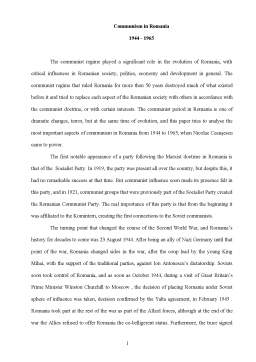Extras din referat
The communist regime played a significant role in the evolution of Romania, with critical influences in Romanian society, politics, economy and development in general. The communist regime that ruled Romania for more then 50 years destroyed much of what existed before it and tried to replace each aspect of the Romanian society with others in accordance with the communist doctrine, or with certain interests. The communist period in Romania is one of dramatic changes, terror, but at the same time of evolution, and this paper tries to analyse the most important aspects of communism in Romania from 1944 to 1965, when Nicolae Ceau?escu came to power.
The first notable appearance of a party following the Marxist doctrine in Romania is that of the Socialist Party. In 1919, the party was present all over the country, but despite this, it had no remarkable success at that time. But communist influence soon made its presence felt in this party, and in 1921, communist groups that were previously part of the Socialist Party created the Romanian Communist Party. The real importance of this party is that from the beginning it was affiliated to the Komintern, creating the first connections to the Soviet communists.
The turning point that changed the course of the Second World War, and Romania's history for decades to come was 23 August 1944. After being an ally of Nazi Germany until that point of the war, Romania changed sides in the war, after the coup lead by the young King Mihai, with the support of the traditional parties, against Ion Antonescu's dictatorship. Soviets soon took control of Romania, and as soon as October 1944, during a visit of Great Britain's Prime Minister Winston Churchill to Moscow , the decision of placing Romania under Soviet sphere of influence was taken, decision confirmed by the Yalta agreement, in February 1945 . Romania took part at the rest of the war as part of the Allied forces, although at the end of the war the Allies refused to offer Romania the co-belligerent status. Furthermore, the truce signed with the Soviet Union on September 12 1944 stipulated "the recognition of Soviet annexations of June 1940, compensations of 300 million dollars, payable in six years in goods […] ensuring freedom of movement to Soviet troops on Romanian territory, the arrest and punishment of persons accused of war crimes, the nullity of the Vienna arbitrage and the restitution of Transylvania to Romania." The only obvious benefit for Romania was regaining Transylvania, but the price paid in exchange is more than 50 years of communist rule.
PCdR, although a small party at the time, gained more and more influence due to the help of the USSR. As part of the coalition that brought down Antonescu, together with PN?, PNL and PSD, PCdR would have been entitled to be part of the newly created government, but this would have ensured PNL and PN? a comfortable majority, as the seats would have been distributed considering the political importance of each party. Due to this fact, PCdR, a small party at the time, compared to PNL and PN?, wanted to destabilize the government in order to take control, by using several methods. Communist leader Lucre?iu Patr?scanu, and the leader of PSD, who was in tight relations with PCdR, Titel Petrescu resigned from the government, thus creating a political crisis, while protests organized by PCdR increased the pressure on the government. In January 1945, Stalin instructed Romanian communist leaders Gheorghe Gheorghiu-Dej, Ana Pauker and Gheorghe Apostol in a meeting in Moscow, in order to gain support for FND, an alliance created under communist control. Amongst these there were several measures, such as an agrarian reform, that would except Royal and Church properties, and implementing the idea that the USSR would only trust a government lead by FND to give Northern Transylvania back to Romania. As for the position of General Secretary of PCdR, between Ana Pauker and Gheorghiu-Dej, Stalin chose the latter, as he had his roots in the working class, and would be trusted more, unlike Pauker, who was Jewish and originated from the bourgeoisie. Although he was the formal leader of the party, at that time, Dej did not have
Preview document
Conținut arhivă zip
- Communism in Romania 1944-1965.doc




















